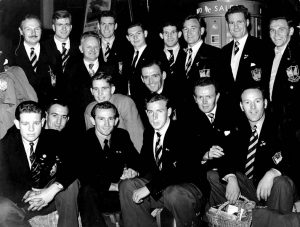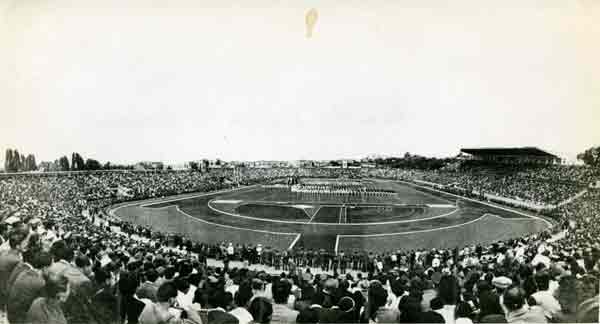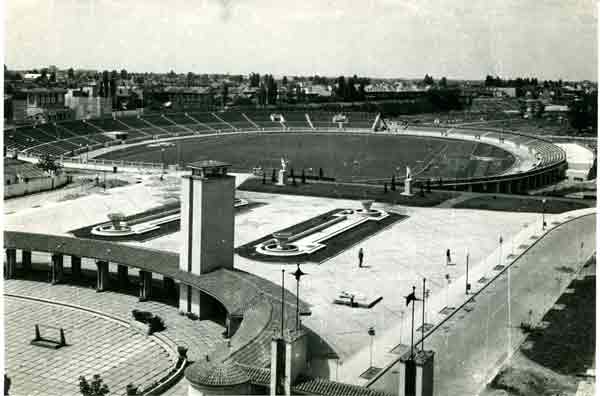
The following article has been submitted by Cosmin Gregore and Lewis Douglass, studying at Swansea university:
Swansea RFC behind the ‘Iron Curtain’ – The Whites tour to Romania in 1954.
In 1954, Swansea RFC were invited to take a pre-season tour in Communist Romania, which made the ‘All Whites’ the very first Welsh team to play behind the Iron Curtain. They were to play against Locomotiva Bucharest and Constructorul Bucharest. The rugby games, as the other sportive games, had been organized to celebrate ten years since liberation from Nazi Germany, from 23 August 1944 and the national day of the Popular Republic of Romania from 23 August 1954.
During the 4th World Festival for Youth and Students hosted in Romania in 1953, where 30,000 young people would attend to compete in various sporting events. The Romanian rugby team won against a French workers’ committee representative team and a secondary Australian squad and asserting the level of skill that they possessed. Welsh swimmer, Dick Smale attended the festival was impressed with the work the Romanian authorities had put in as they had invested heavily in sports infrastructure, and they brought in food from several regions to feed the large influx of people. Dick Smale had been asked by the Romanian authorities to suggest a Welsh rugby club to play in their 1954 event. Smale decided to ask Swansea RFC Committee member Bruce Barter about the tournament opportunity in Romania. Ultimately, The Romanian authorities chose Swansea RFC to the detriment of Cardiff and Cambridge University. They considered Swansea a better squad, especially playing away.

The All Whites departed for Romania on 16th August 1954, where a team dressed in blazers, flannels and sporting the traditional club tie embarked on their pre-season tour. Swansea’s skipper R.C.C. (‘Clem’) Thomas felt, “the trip can do nothing but good. The game of rugby is obviously spreading throughout the world, and we will do our best to carry on this good work.” The Swansea team travelled by bus towards London where they would spend the night before flying to Brussels the next day. Once they arrived in London, the team were entertained at the Romanian embassy, where they were served food, good wine and viewed presentations about Romania. It was planned that the Swansea team would fly from London to Brussels, then fly again to Prague and from there have the Russian Government Air Service escort the team to Bucharest. However, the team experienced much difficulty when two of the travelling three planes from Prague to Bucharest needed to land back on Prague after encountering a heavy storm over the Carpathian Mountains. Passengers on board the two planes, including Tour Manager Row Harding, had to wait until the next day to catch a flight into Romania.

Pennant presented to Swansea RFC by the Constructurol club Swansea played their first game of this pre-season tour on Saturday 21st August 1954 against Locomotive Bucharest, who were champions of their country at that time. The match was played at the National Stadium of Romania which opened in 1953 and was a way of showing off their impressive stadium. A crowd of 45,000 and temperatures of 32C welcomed the Welsh team onto the field. Due to the extreme heat, Swansea was outplayed by the Romanian side, who scored 14 points without any reply from the All Whites. As the second half began, the sun started to set, and the temperatures became cooler, and Swansea were able to open up and play with more conviction. However, the blistering heat in the first half proved to be too much as the game ended 23-12 to Locomotive Bucharest.

The first game having been played, on Saturday 21st August the Swansea party were guests at the “Stadionul 23 August” to watch with a crowd of 80,000 the official celebrations for the Liberation day. Then the Swansea team were given time to relax and explore Bucharest. In between the two scheduled matches, members of the team can be seen in photographs relaxing next to a lake in Bucharest and getting involved in water activities at the hotel swimming pool. An interpreter had been placed at the team’s disposal and they were allowed to go as and where they pleased, although their hosts “did like them to have some sort of timetable arranged.” Swansea RFC were scheduled to play their next game on 25th August 1954 against the Asociata Sportiva Constructurol club. However, due to the extreme heat in the first game, the Swansea team requested the game to be delayed until the temperatures dropped in the later hours. The Romanian Rugby Federation graciously accepted the request, as they believed in putting the players well-being before everything. The game was therefore delayed until Thursday 26th August 1954 at 5:30pm, at the Dinamo Stadium, Bucharest. The All Whites put on an impressive display, winning the game 16-5, with Owen Hughes and Jim Rees scoring tries the Welsh team.
The Swansea team left Romania on August 28th, 1954, taking a direct flight back to London, and a bus back to Swansea. The tour had been a success and the All Whites were impressed by the country and the level rugby from their opponents. Tour Manager, Row Harding expressed his astonishment on the ability of the Romanian teams, “We knew they were good before we went there, but I did not expect them to be as good as they were. They had a natural genius for their game and have all the basic skills …. They tackle hard, their covering defence is magnificent, and they pass the ball at top speed.” Interestingly, the Romanian authorities learned a lot from Danie Craven’s handbook on rugby (Danie Craven on Rugby, 1953) that Clem Thomas gifted to the Romanians. Moreover, the referee for the Locomotive Bucharest vs Swansea game, Roger Taddei, was also impressed with the level of skill within the Romanian side stating, “I was amazed… the Locomotive’s forwards made a good game in all compartments, as well as out-performing Wales players in the execution of actions. Also, all the spectators attending the match appreciated the skill, speed, and efficiency of the Locomotive’s forward line. The Swansea team, who played an energetic and combined game, was overtaken by the speed of the Bucharest players…especially during the first half.’’


After the first trip across ‘Iron Curtain’ where they had been well received, the British authorities and then Swansea RFC returned the compliment and a Romanian XV toured in Britain in September 1955. The Romanian XV’s tour of Britain in 1955 allowed them to play three different teams, beating Swansea 19-3, losing to Cardiff 3-6, and drew with Harlequins 6-6. This time, the Swansea team was surprised by the Romanians new tactics and impeccable fitness. There was also some propaganda as Gheorghe Parcalabescu, the Romanian captain, recited communist poetry with workers and held a lot of interest with British factories. It was a pleasant atmosphere and the hosts were most hospitable. A Romanian representative team came back to the UK in 1956 where they drew with Leicester Tigers, 6-6 and won against FC Gloucester.
In a dramatic finale to the Romanian XV visit to Swansea, ‘All Whites’ players Dil Johnson, Matty Davies and Davies’ wife were involved in aiding the defection of (defecting is the desertion of one’s country or cause in favour of an opposing one, without special permission) Romanian player Luric. Matty Davies and his wife, who spoke French, the only foreign language known by Luric, entertained him until, in a pre-arranged rendezvous, MI5 took him away from the area.
To conclude, Swansea RFC were the first Welsh team to play behind the ‘Iron Curtain’ which was a successful experiment because they had the opportunity to enjoy visiting Romania’s capital and play in a communist country that invested all effort in sports science, and fully preparing the teams physically. Furthermore, it was a great event for Romanians, as it gave them the chance of improving their rugby by playing against a British Team and it was all part of Romania’s drive to move away from the Eastern Block and forge new political and economic relationships with the West.
The two stadia that Swansea played in during the historic tour…
“Stadionul 23 August” Bucharest…


Stadionul Dinamo, Bucharest…


